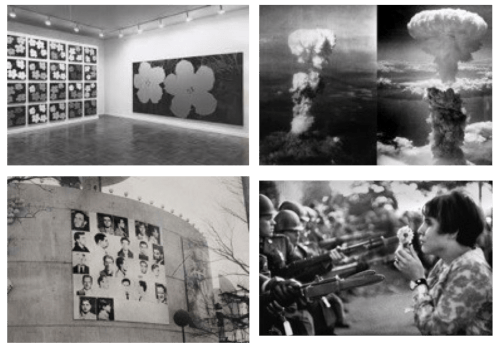
Andy Warhol 1964
Flower Paintings and 13 Most Wanted Men
For today’s blog, the gallery invited Massimo Barzagli to reflect on Andy Warhol’s work in relation to the cultural revolutions of the early 1960s. Massimo Barzagli is an artist and Chair of Contemporary Painting at the Albertina Academy of Fine Arts in Turin, Italy.
It appears as no coincidence that these two large installations are realized in the year 1964.
The Vietnam War is in full swing and many young people, who had left for service in the mid 1950s, are returning home as Martyrs; their bodies given back to their families wrapped in very colorful Flags and then buried in monumental cemeteries dedicated to war heroes.
In that moment, a whole generation—Beat and then Hippie—cried out across the planet in outrage. Pop stars joined the chorus with artworks that amplified their powerful chants and slogans, and possibly even inspired new ones.
WAR IS OVER! If you want it
The masses of this new generation were certainly closely observed by intellectuals like William S. Burroughs and architects like Philip Johnson. Precisely in 1964, Johnson commissioned Andy Warhol to create a work for the exterior of the New York State Pavilion that he designed for the World’s Fair. “Warhol chose to enlarge mug shots from an NYPD booklet featuring the 13 most wanted criminals of 1962. Forming a chessboard of front and profile views, 13 Most Wanted Men was installed by April 15, 1964, and painted over by Fair officials’ direction with silver paint a few days later.” [1]
Concurrently, Leo Castelli was exhibiting the large installation of Andy Warhol's Flower Paintings at his gallery in uptown Manhattan. Considered together, Flower Paintings and 13 Most Wanted Men appear to be linked by a commemorative aspect. Warhol’s concern that his artwork might further endanger the lives of the most wanted men leads us to see one exhibit as commemoration or a tribute to the other.
This strategy employed by Andy Warhol has a theatrical and cinematic aspect, not to be neglected. In the exhibition at Castelli, the large Canvas, Flowers, on its own dedicated wall, looks almost like an aerial view of two large nuclear explosions. The walls, covered in small Flowers paintings like Small Tombstones, may certainly recall a monumental cemetery. No less than Walter De Maria's overwhelming The Earth Room, 1977—created at the end of the war—recalls the shape of a Mass Burial, or, of what was left of Earth after the passage of human disasters caused by the wars —World War II, the Korean War and the Vietnam War. Therefore, commemorating the torment of a generation almost totally consumed, both physically and morally.
This interpretation partially reflects the cultural debates of the time, which raged throughout the 1960s in all the Countries of the World.
Obviously, these debates began in the US, but the country soon became part of a worldwide debate. The debate remained most intense in the US, where the artists took on a deeper sense of responsibility, possibly compensating for the lack of accountability by the political leaders, be they Democrat or Republican.
At this time, that Beat Generation transformed Manhattan below 23rd Street into a large Factory. Andy Warhol, of course, was certainly one of the reference figures of the time, together with an entire community of Artists, Musicians, Poets, Literary People, Architects, Museums and Galleries. But we can't forget an entire generation of Young Masses who contributed to the transformation of Manhattan into One Big Factory.
The Cycle of Flower Paintings has such a level of complexity that no single reading can ever be exhaustive. All of Warhol's work compels us to continue to analyze it, to reveal new details or different perspectives. I would personally characterize a general through-line, which could be that of the death of the
image in sacrifice to the artwork, or ripping apart already dead images to turn them into ghost-like images, or ghosts of images.
Obviously, this position would drag the work into a Minimalist drift. It would be instructive for the interpretation I am trying to propose, if only we were able to exhibit and see together the entire group of Flower Paintings, DeMaria's The Earth Room, and the 13 Most Wanted Men. Or, similarly, if we could see the large Flower Painting and The Earth Room together.
Flower Power may indeed have began inside the walls of the Metropolitan Museum, in rooms where artists spent time observing the work of past painters and confronting them with their own. The Flower Power extends from Henri Fantin-Latour to Charles Baudelaire, who in his dark masterpiece, Les Fleurs du Mal, indeed placed flowers in the kingdom of evil [2].
Up until our present day, from Claude Monet to Jackson Pollock, Roy Lichtenstein, Andy Warhol, Walter De Maria, Richard Serra, from Vincent van Gogh to Anya Gallaccio, Flowers have often marked the commemoration of something. Flowers first commemorate the moment in which, cut from the stem, they are nurtured just a little longer by the water of a vase, by the light of a room, by the brief glance of someone who, from that moment on, admires them only as a painting.
Among all the Painters, Andy Warhol indeed seems to be the artist who, above anyone else, aims to reveal the inevitability of the Death of Flowers. Of ideas, of ideologies, of faiths, until today, looking out on the edge of the precipice of nothing.
Taking note of the premonition of the Artists, we could say that Reality Imitates Art.
1960/2020
-Massimo Barzagli, Artist, Chair of Contemporary Painting at the Albertina Academy of Fine Arts, Turin, Italy
[1] "13 Most Wanted Men: Andy Warhol and the 1964 World's Fair." Queens Museum website, November 2013, https://queensmuseum.org/2013/11/andy- warhols-13-most-wanted-men-and-the-1964-worlds-fair.
[2] Alberto Boatto writes of “regni malsani della perdizione” in the catalogue of the exhibition “Les Fleurs du Mal” at the Galleria L’Attico, Roma, 1994.